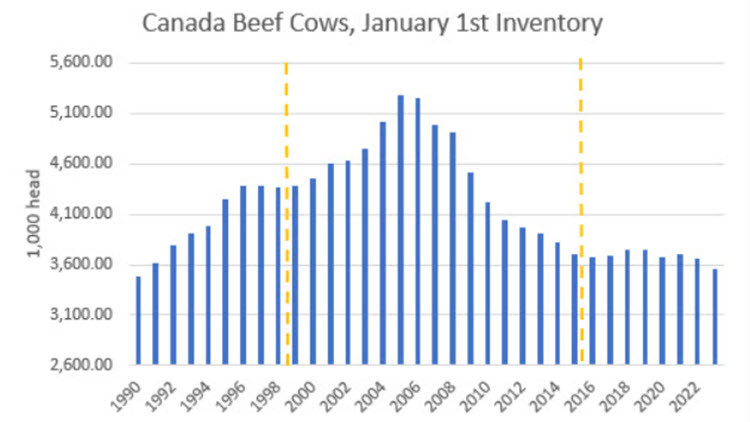Non-urgent government operations are closed December 24 to January 1, reopening January 2. View available services during this period.
See event listings and more articles in this edition of Agri-News: June 5, 2023 issue
“Any expansion will be dependent on this year’s weather, feed costs and conditions in the second half of 2023,” explains Ann Boyda, provincial livestock market analyst with the Alberta government. “Expansion is dependent on increased profits for the cow-calf sector.”
Calf (550 pound) and feeder cattle (850 pound) prices have reached highs not reported since 2015. With anticipated tighter feeder cattle supplies, prices continue to climb. Cost of gain is also improving due to lower barley prices.
“These conditions may have producers retaining or purchasing heifers or retaining females that they may have otherwise culled,” says Boyda.
Data from CanFax reports Western Canada bred heifer prices in February and March 2023 at levels of 30% to 40% higher than the same period in 2022. Slaughter volume of heifers for the first 3 months of 2023 was 15.4% lower than the same period in 2022. However, slaughter volume of cows remained 11.5% higher over the same period.
“To help gain further insights into prospects for herd expansion, we look at the cattle cycle for a longer-term perspective. A cycle is defined as the period from the low point in inventory, through the peak and back to the next low point. These cycles typically run between 8 and 10 years.”
Beef cow January inventories as reported by Statistics Canada have been declining since 2005. Although there have been short-lived periods of rebuilding from 2016 to 2019, the herd again faced more contraction. The January 1, 2023 beef cow herd at 3.56 million head was down 2.5% from the previous year, approaching the lowest level since 1990.
“If more rainfall returns to Alberta this summer, producers may retain more heifers. But weather is not the only challenge. Issues of agricultural labour shortages and an aging producer demographic persist,” explains Boyda.

The U.S. beef cattle cycle is more identifiable. Expansion between 2014 and 2018 was followed by the current contraction phase. The U.S. beef herd is in the ninth year of its current cycle. The January 1, 2023 U.S. beef cow inventory at 28.9 million was reported to be 3.6% lower than U.S. beef cow inventory from the previous year. This inventory is the lowest level in nearly 60 years. The continued contraction was attributed to drought conditions and record high prices for feed.

“Increased liquidation through 2022 implies tighter supplies for 2023. Cattle and beef prices may remain strong which could encourage rebuilding. Despite inflationary pressures, consumers are still demanding this preferred protein. With grilling season around the corner, prices should remain strong into summer,” says Boyda.
For more information, see:
Contact
Connect with Ann Boyda for more information:
Phone: 780-422-4088
Sign up for Agri-News
Start every Monday with the week’s top agricultural stories and latest updates.
Read about all things agriculture at Alberta.ca/agri-news